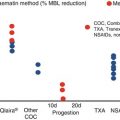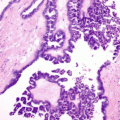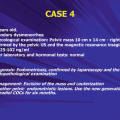© International Society of Gynecological Endocrinology 2015
Bart C. J. M. Fauser and Andrea R. Genazzani (eds.)Frontiers in Gynecological EndocrinologyISGE Series10.1007/978-3-319-09662-9_1919. Androgen Receptor and Breast Cancer
Piero Sismondi1 , Marta D’Alonzo1, Valentina Elisabetta Bounous1, Francesca Quintili1, Anna Maria Ferrero1, Luca Mariani1 and Nicoletta Biglia1
(1)
Department of Gynecology and Obstetrics, Mauriziano Hospital, University of Torino, Largo Turati, 62, Torino, 10128, Italy
Androgen receptor (AR) is a member of the family of steroid nuclear receptors which also include the estrogen and progesterone receptors. It has a number of ligands including the endogenous testosterone (T) and 5-dihydrotestosterone (DHT) as well as a variety of synthetic agonists and antagonists, and it is involved in a complex network of signaling pathways that collectively regulate cell proliferation. Androgen receptors (ARs) are frequently expressed in breast cancer (BC) cells, but molecular mechanisms underlying BC progression and their implication as a prognostic and/or predictive marker in BC patients are still controversial. Long-debated issue are: the androgen effect on BC cell lines, the prognostic significance of the presence of ARs in the different BC subtypes, and the resulting clinical implications of ARs’ expression in breast cancer patients.
Androgens are the major circulating sex hormones in females. In premenopausal women testosterone is mainly synthesized and secreted by the ovaries and adrenal glands, with additional biosynthesis occurring within peripheral tissues via metabolic conversion of circulating adrenal proandrogens. In postmenopausal women, large amounts of active androgens and the totality of estrogens are synthesized in peripheral tissues from the adrenal precursor dehydroepiandrosterone (DHEA). A part of testosterone is metabolized to estradiol as a result of activity of aromatase. In normal breast tissue, androgen and AR signaling exerts an antiestrogenic, growth-inhibitory influence, and the relative levels of circulating sex hormones influence the proliferative capacity of breast epithelial cells. In the absence of estrogenic hormone stimulation, postmenopausal breast tissue undergoes a progressive involution characterized by increasing atrophy of glandular tissue and fibrosis of the stroma. These morphological changes may be due to unopposed androgen action.
The clinical-pathological implication of the androgen/AR pathway on breast cancer growth is not yet well known. Preclinical studies suggest that the action of androgens is bidirectional: mainly proliferative, because circulating androgens are the precursors of estrogens, but also antiproliferative, because AR activation restrains ER activity, inhibiting normal breast tissue growth.
The proliferative action is indirect: testosterone is metabolized by aromatase within breast tissue to 17-estradiol (E2), that is the most potent natural ER-ligand. Therefore the influence of circulating testosterone on the proliferative capacity of breast epithelial cells is in part dependent upon the relative expression and activity of aromatase. In studies of transgenic mice that overexpress the aromatase gene (AROM), males undergo abnormal breast development due to excess exposure to estradiol. Administration of an aromatase inhibitor (AI) to AROM transgenic male mice causes involution of the breast tissue, regression that is associated with increased exposure to testosterone, and induction of AR expression in the breast epithelium [1].
The antagonistic cross talk between AR and ER explains the antiproliferative action of androgens on ER-positive BC cells. In molecular study, AR did not bind to ERß, suggesting that this oppositional mechanism is specific for the ERα-isoform [2]. Peters et al. [3] demonstrated that loss of AR expression is significantly associated with poor 10-year survival outcome in grade III invasive breast ductal adenocarcinomas. They also evaluated potential regulatory mechanisms that may account for the loss of AR expression. Showing that DNA hypermethylation in the AR promoter is associated with loss of AR expression in breast cancer cells.
Recently, the androgen receptor is intensively discussed as a prognostic and/or predictive marker in BC patients. The AR is the most prevalent sex steroid receptor in in situ, invasive, and metastatic breast cancers, occurring in up to 90 % of primary tumors and 75 % of metastases [4]. AR-positive phenotype was found associated with favorable tumor characteristics, such as small tumor size, low histological grade, ER- and progesterone receptor (PR)-positive status, and with better outcomes than in patients with AR-negative tumors [5]. However, ARs play different roles at different stages of disease or in different subtypes of BC, and their significance is still under investigation.
ARs are expressed in up to 70 % of ER-positive BC. High levels of ARs confer a survival advantage, which suggests that ARs action may have a tumor-suppressive effect in malignant ER-positive BC cells. In this subtype of BC patients, AR expression is also associated with chemotherapy responsiveness [6].
Hickey et al. [2] observed that AR positivity was over 75 % in the large majority of prospectively collected cases of ER-positive breast cancers. This degree of AR positivity was higher than that observed in normal breast tissues. They hypothesized that AR levels increase with the progression of ER-positive tumor in a homeostatic attempt to restore the balance of sex hormone activity that normally regulates mammary epithelial cell proliferation. Failure to upregulate AR signaling may result in insufficient androgenic antagonism.
As mentioned above, multiple studies show that AR levels predict positive outcomes for women with luminal breast cancers; Castellano et al. [7] showed that AR is an independent prognostic factor in the luminal B subtype, which is a more aggressive form of luminal disease. They developed a new prognostic index (PI) specific for ER-positive breast cancers (ERPI), in contrast with other PIs that have been created for breast cancer in general. This new ERPI takes into account the expression of AR and demonstrates the prognostic relevance of its expression in breast cancers.
Stay updated, free articles. Join our Telegram channel

Full access? Get Clinical Tree







